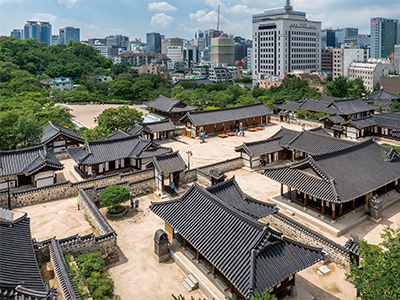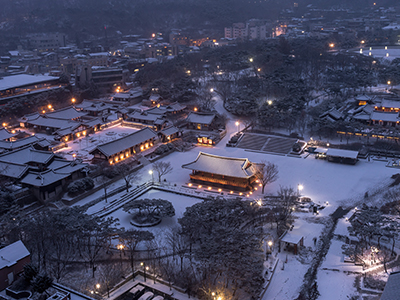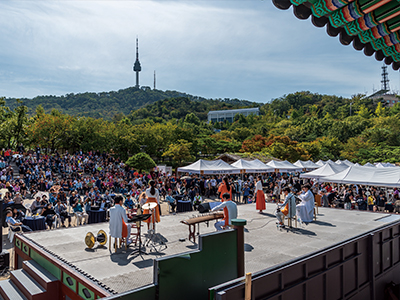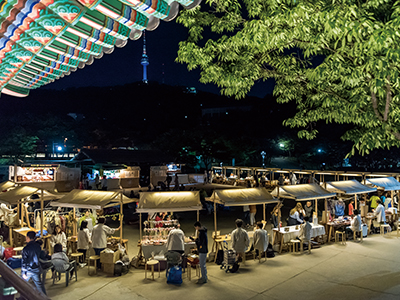“Tradition” should connect with the world
It is the same place but it presents itself in diverse ways to the world. Every time flowers bloom or trees shed leaves, when the rain falls or the dusk begins to gather, Namsangol Hanok Village changes its appearance. This is because the natural environment and features surrounding the hanok houses, and the hanoks themselves, keep unceasingly changing. Han never gets bored here. Instead, he meets new people every day and puts on a new show. His days in the village are always full of inspiring events.
“I came here last March. If you stay here, you celebrate the traditional Korean holidays and the 24 divisions of the year in an authentic way. We hold traditional ceremonies not only for Chuseok (Korean Thanksgiving Day) and Lunar New Year’s Day, but also for Ipchun (the beginning of spring), Daeboreum (the day of the first full moon of the year), and Dongji (the winter solstice). While standing in the very center of Seoul, a modern metropolitan city, I can still feel the seasonal changes throughout the year. I can’t wait to see the beautiful scenes that each season creates. The hanok village is enveloped in the unique beauty of every season, even in the dead of winter or in the rainy season,” said the creative director.

▴Namsangol Hanok Village in summer

▴Namsangol Hanok Village in winter
He has always dreamt of sharing the beauty of the village with others. To realize his goal, he came up with the idea of building a brand for Namsangol. Last year, he planned a variety of tradition experience programs using the name of the village, including Namsangol Night Market, the Night Picnic at Namsangol, Namsangol Vacance, Namsangol Art Masters, Namsangol Winter Village, Namsangol Children’s Village, and Namsangol Lamplight Village. Thanks to the time and energy he and his team have poured into these initiatives throughout the past year, they succeeded in publicizing the village and earning it a reputation as a place to visit. Brilliant ideas from his talented team members were the foundation on which they were able to transform the village into a fun and welcoming place.
At the night market, where the streets of Hanyang in the 1890s have been recreated, visitors can enjoy drinking makgeolli (Korean rice wine) and meeting new people. During the period when the Lamplight Village is open, visitors can take a long, pleasant stroll around the hanok village while holding traditional lamplights. The Vacance allows them to sit on the daecheong floor of a hanok house and take a nap there on a summer afternoon, comfort assured with the use of a Dutch wife, which is a special type of pillow. Simply meditating on about these offerings makes Han smile, as it seems they have successfully made Korean traditions less alien to the public.
“Tradition should not remain in a fixed form. It should connect to the perspectives and the people of today, which is the true goal that tradition should pursue. If it fails or refuses to adapt to the dynamic of the era, it will eventually vanish. We believe that while maintaining the values that are worth protecting, tradition should continuously reinvent itself in a way that people can relate to. All the programs we designed were based on such a belief. We offer a chance for the public to have a first-hand experience of tradition, in hopes of encouraging them to evolve from being bystanders to people with a sense of ownership of traditional culture,” he continued.
He also plans to stage quality shows at Seoul Namsan Gugakdang. The traditional theater, situated in the hanok village, has undergone major renovations, supported by Crown Confectionery Group, since Han became creative director of the theater. It is now equipped with the most advanced acoustics and lighting system of all gugak theaters in the nation. By taking full advantage of the facility, over time Han wants to inspire the “gugak sensibility” that is embedded in the DNA of all Koreans. While promoting the excellence of traditional performances, he also has plans to make the theater a hub for a younger generation of gugak musicians, where they can receive the training and support they need. As a result, the theater will become a place where those young musicians can develop their skills and potential, and expand the range of their possible career paths, perhaps branching out from giving on-stage performances to planning events or managing art institutions.
The fruition of a dream
Some people are meant to be the way they are, after taking all the right or seemingly wrong paths through the course of their lives. It seems that they were born for the job they now have. Han is one of those lucky people.
He was born in a hanok house, which was located in a village where the Han clan lived near Gunpo in Gyeonggi-do Province. He could easily visit his third cousin’s house, which was near his home.
Everything surrounding his childhood formed a microcosm of traditional Korean culture, and his college life was not very different from his early days. He entered Korea University, where the traditions and dedication to the nation of the Korean people was emphasized, and majored in Korean Language and Literature, a subject area that had and has many inter-relationships with the culture of gukak.
Han confesses that studying language and literature at Korea University opened the door to traditional Korean culture for him. It was 1998 when he began working in the field of traditional culture in earnest, when he set up a small company with his acquaintances from the university. There, he started to develop content that was infused with traditional ideas, which later inspired many.
“After thinking long and hard, I conceived the idea of re-enacting the coronation ceremony of King Sejong. Coronation ceremonies during the Joseon Dynasty were generally simple and modest, as they took place during the period of mourning for the previous deceased monarch. However, King Sejong's ceremony was very flamboyant, as King Taejong had voluntarily abdicated to allow his son to take his place on the throne. King Taejong wanted to inculcate respect for himself and for his son by having a grand ceremony, thereby sending an implicit message that no one should look down on Sejong, even though he was the third son. My idea was to re-enact the ceremony, based on thorough historical research. You can now search for and gain access to various historical records on the Internet, but back then there was no alternative but to delve into the original historical records. It was quite a journey that we went on in asking historians to interpret those records precisely,” he said. Han completed a 60-page proposal, which presented the purpose and the expected effect of the performance, and submitted it to the Ministry of Culture and Tourism.
Aside from the proposal, he also produced video clips to be presented to the minister. In order to impress him with an engaging rendition of the proposal, Han incorporated background music and narration into the videos. Upon accepting his proposal, the ministry allocated a budget for the project. Based on his experience of writing play scenarios in high school and his writing skills as a Korean literature major, Han decided to write a scenario for the performance himself. The ceremony, based on his scenario and conducted under his direction, was performed 10 times each week for 10 weeks.

Every day is a new day
Approximately 400 actors and actresses appeared in the re-enactments over the course of the run. Some of the top actors in Korea, including Soo-jong Choi, Jae-mo Ahn, Bul-am Choi, and Ho Lim, were happy to appear on stage. Visitors to the performance venue were all thrilled to see the coronation ceremony reproduced. Everyone seemed to be infatuated with a setting in which they could met King Sejong as if they had taken a time machine and gone back to the era of the Joseon Dynasty.
“It was the end of the run when I realized how big our show was and how meaningful it was. I kept reminding myself of things I could do better. Since then, I have done a lot more research. From Royal architecture, Royal music and dance and court cuisine to Royal court ceremonies, I have studied every facet of the traditional Royal culture and found myself truly fascinated by it,” says Han.
He pored over books about Royal culture and tried not to miss any lectures given by experts in related fields. The deeper his knowledge became, the more that projects related to traditional culture were offered to him. He diversified his career, and has been a content-planner who interpreted the traditional cultural heritage from a modern perspective, a critic who wrote about traditional culture in an insightful way, and a consultant for TV series or movies which put a premium on historical accuracy. From 2010 to 2015, he worked as the creative director of the Unhyeongung Royal Residence. He can vividly remember how beautiful it was walking through Irodang, Norakdang to Noandang. During nights when all the lights from nearby office buildings were off, the royal residence itself still shone, even under the dim moonlight.

“If you are truly in love with a space, you can see something new there every day. You can be just as happy every day as if you were in the space for the first time,” he says. Han refers to his current affiliation as “Zelkova Academy.” The academy, which sits in a certain place on any given day, can move to another place the next. However, one day, he wants to build his own permanent venue and name it the Zelkova Academy. It will be a welcoming place for everyone who wants to study and share quality time with each other. It can also potentially be a research institute for the greater understanding of traditional culture. Han's life is concrete proof of the fact that dreams come true in the end as long as you devote yourself to them. It seems that his visionary Zelkova Tree has just begun to bud.



